Bamboo, as a natural material, manifests boundless potential in the application of contemporary lifestyle. Bamboo flooring, combined with energy saving LED, forms a new type of green building materials; the toughness and flexibility of bamboo fiber make it possible for the building of a solid and shockproof bamboo house; the interior display of all sorts of bamboo-made design products, well illustrates the potential of Chinese traditional bamboo crafts in the form of modern designs.
I. Bamboo and Chinese culture.
Local climates, geography and cultural traditions all affect the human mode of existence. The same elements beget the corresponding style of design, which often works to represent the wisdom of the people living in a certain area, such as how men interact with nature, and become harmonized with tradition. Southern China, due to its warm climate and suitable conditions, has an abundant supply of bamboo. Since ancient times, Chinese people have utilized bamboo as material for constructions, furniture, containers, and even art pieces. The region celebrates a long history of bamboo arts and crafts.
Easy to procure, bamboo in ancient China was once used to produce various instruments. Bamboo matting, and bamboo baskets, a proof of ancient bamboo craftsmanship, were found in the unearthed relics of Hunan Gaomiao culture and Zhejiang Liangzhu culture. According to historical records, bamboo materials began to be utilized in large amounts during the West-Zhou Dynasty. Throughout China’s long history, bamboo workshops have been continuously producing furniture pieces and various vessels for everyday use, such as bamboo chairs, bamboo beds, bamboo baskets, bamboo sieves, and various art pieces such as pen-containers which are carved from bamboo roots.
In the Buddhist paintings produced during the Tang and Song Dynasties, we can find images of bamboo furniture as Yoke-backed Arm chairs (四出头官帽椅), footstools, etc. Bamboo craftsmanship reached its prime during the Ming and Qing Dynasties, when literati preferred delicate bamboo carvings for decorating their studies. A peak of bamboo craftsmanship was evident at that time. Take the bamboo carving pen-containers for example: bamboo carvers would reproduce on the surface images such as hills and valleys, figures, flowers, birds, and pavilions, all of which are frequent keynotes of traditional scholar paintings, representing the pensee of a retired life. Bamboo works in this period were transformed from practical to artistic use, and were appreciated and collected by artists. Ji Xiaolan, a famous scholar of the Qing Dynasty, and Wu Changshuo, a master painter who lived during the late Qing Dynasty and the early Republic of China period, are both celebrated for their calligraphy and painting art, as well as their collections of bamboo carvings.
Bamboo in Chinese tradition also bears the ideals of literati in all ages, owing to its solid roots, hollow inside, regular nodes, ever-green quality, and resistance to cold. Su Shi, a notable scholar of the Song Dynasty, once remarked, “One can live without meat, but never without bamboo. The absence of meat reduces one’s weight, but that of bamboo, the nobleness of man.” Bai Juyi, a Tang poet, compared bamboo to a virtuous person, praising bamboo as “solid in virtue, upright in character, hollow as a modest scholar, and determined as one of lofty ambitions.”
To sum up, bamboo plays a vital role in traditional Chinese culture: it is both of practical use in daily life, and of artistic value in terms of aesthetics and art; meanwhile, it is a source of inspiration, bearing the great mission of moral education.
II. 21st century: a turning point in the concept of “Created in China
The end of the 19th century witnessed the start of the Industrial Revolution during which machines replaced manpower, delivering a revolutionary change covering manufacture mode, efficiency, productivity, etc. It was followed by the Green Revolution in the 20th century, when agricultural technologies were developed to increase production and in a way relieve the population pressure. However, it also entailed extensive overuse chemical fertilizers and pesticides, causing the deterioration of vast amounts of soil and the destruction of the ecological environment.
Development since the Industrial Revolution has relied heavily upon the vast consumption of resources. The unceasing emission of greenhouse gases has lead to global warming and rapid climate change. Research shows that half of the earth’s resources already been consumed; and scientists have gone so far as to predict that by 2030, in order to satisfy humanity’s needs, the resources of two Earths will be required.
Industrial design, a product of the Industrial Revolution, plays a direct role in destroying the Earth’s natural ecology. Fortunately, our development today is shifting from high energy consumption to a low carbon mode. The definition of industrial design, in the 21st century, ought to be modified, too. We must understand that, sciences that merely serve the greed and arrogance of human beings are unsustainable.
Developed countries and regions such as Europe, the United States, and Japan, who have benefited from the follow-up development of the Industrial Revolution, having obtained a multi-national advantage with regard to politics, economics, culture, science, and colonizing experience. Since the end of the 20th century, these nations have resorted to the wisdom of ancient civilizations. Now, why would these countries turn to the traditional arts and crafts of ancient civilizations?
Industrial design, though it has satisfied humanity’s needs with respect to survival and living quality, is resource-less in dealing with nature. It works only to ruin the environment. On the contrary traditional craftsmanship is environmental, in that it lives in harmony with nature. The materials adopted in traditional arts and crafts are mostly natural, the processing of which also complies with the laws of nature. Most works are handicrafts or semi-mechanized productions.
It is most important that traditional folk arts and crafts be simple and unsophisticated, humble, mild, tender reasonable, and never going against nature. This echoes the Chinese philosophy which reveres Heaven and pursues both the harmony between man and man, and that between man and nature. It never pretends that men are in any way superior to nature or can ever conquer nature. It is simply this commonplace notion that defines the rarity of Chinese cultural resources in the global context of the 21st century. And that is the true essence of the phrase “Created in China”.
Design with an “emotional orientation” today is intended to meet the spiritual needs of human beings, thus affording a high added-value; while design meant only to satisfy low demands is only capable of a low added-value. Traditional philosophy and art prevalent before the Industrial Revolution was deemed out of date by those people who chose to follow western design concepts. Now when it comes to the turning point of the 21st century, when we are confronted with a ruined ecology, sustainable, traditional Chinese design is experiencing resurgence. Now we can recognize that traditional philosophy and art is the fountain of creation, without which it is impossible to transcend cultural limits and exchange design ideas with other civilizations.
III. Appearance of bamboo houses: a representation of traditional bamboo craftsmanship
Now I will use bamboo design to illuminate the above-mentioned ideas. All items in the exhibition are made of bamboo; chemical materials are avoided wherever it is possible. Hemp ropes are used to fasten the house structure.
There is a sort of arrogant architects, who believe that architecture should contend in bizarrerie and beauty; moreover, they require their name be recorded upon their works so that they will be remembered forever in the world. In their eyes, architecture is designed only to elongate the existence of their spirit. To this end, they try to invent various models, without considering whether these are seasoned with local geography and lifestyle.
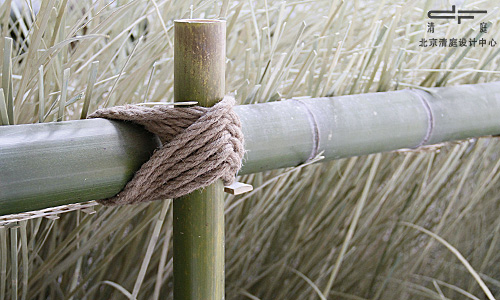
“Bamboo Project” as much as possible not to use synthetic materials,
build bamboo house structure, but also to assist the fixed rope.
Though not a professional architect, I am totally against such an idea. I created the bamboo house based on a different idea: I want to build a humble structure/space. To be “humble” means that I reject the arrogant idea mentioned above. I produced the design not to make a name for myself. Quite the reverse, I hope someone acquainted with the nature of bamboo, one who knows about bamboo craftsmanship, when he sees the bamboo house, will obtain an intimate feeling. I hope such an audience will believe that one without design talent will also be able to create such a structure.
I spent a lot of time rationally calculating the structural details of the house. A variety of workmanships are involved. Still I tried to be modest, using the power of design to cover up the marks of artificial calculations. I did all I could to simplify the connotations, so that it is accessible to an average audience, and even feel it nothing difficult at all to understand. It is by no means my goal to scare the audience away, believing that such a product requires high technology and is therefore unachievable.
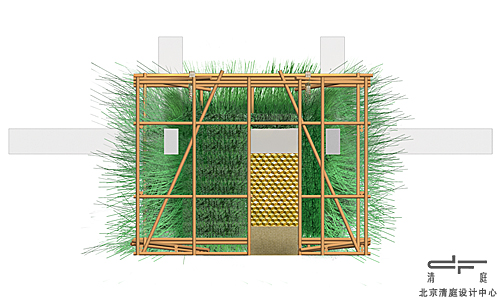
Bamboo house, 3D Rendering - Front view
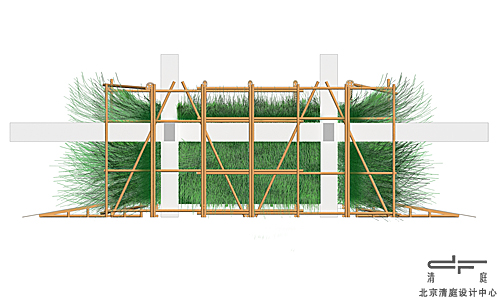
Bamboo house, 3D Rendering - Side view
I have deliberately invented a natural form for the house so that visitors at the entrance will smell the scent of bamboo. However, it is still unnatural; it is after all an artificial effect. Such a contrast shows that human wisdom is limited. Imitation, however successful it is, can never exceed the creativity of nature. Arrogance is not allowed here. Delivering one’s talent and gifts in a restrained manner will humble, and thus appease, a modern mind.
The appearance of the bamboo house has a free intertexture, an organic form resembling a hedgehog, which is an application of traditional arts and crafts. The laws of nature are also reflected in the materials: bamboo is gathered between the mid autumn and spring festival, during which, thanks to a dry climate, the bamboo generally has less water and sugar content, thus increasing its resistance to borers. It is an echo to solar periods (节气). Here we represent the ancients’ wisdom in revering heaven and complying with nature.
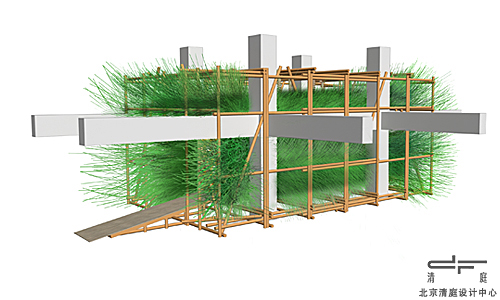
Bamboo house, 3D Rendering - Perspective view
In addition, there are other principles to be followed. Bamboo should be felled without hurting their roots. Those which have grown for about four or five years are preferable, because they are of the best quality. It should be noted that the diameter of bamboo has nothing to do with its age. Therefore, the gatherers should try to find the highest quality bamboo according to their own knowledge and experience. The bamboo we required in the house design, which needed to be straight, were all chosen according to the experience of the gatherers.
In order to protect their skin, the bamboo is wrapped when it is felled and transported. We do this to protect the natural beauty of the bamboo. The fruits of nature need to be cherished. This also reflects the modest, mild spirit of traditional arts and crafts.
My design is only an attempt which is focused on bamboo. As for the other materials which are used in traditional arts and crafts, I believe there will be similar processes. What should be valued is the traditional philosophy of creation. We should review and discuss the traditional arts, and implement science principles that go well with nature, thus developing a mentality of design that grows out of Chinese culture. Only then can we share our culture with other nations. Only then is it possible to exchange design ideas with other civilizations.
In contrast to ordinary trees which have to grow for decades before reaching maturity, bamboo enjoys a faster growth period, requiring only a couple of years before it can be used. Bamboo is an evergreen plant with a host of branches and leaves that can help to protect soil from the rush of rains. Its roots, thickly networking in the surface soil, are able to hold water and soil. Bamboo affords an oxygen emission and carbon dioxide uptake which is 35% higher than the general forests of the same area. Using bamboo instead of wood will contribute significantly to low carbon programs.
In disaster-stricken areas, such as those afflicted by floods, earthquakes, or extreme climates, bamboo may be used to rapidly construct interim houses when existing houses collapse. During the 2008 Wenchuan Earthquake, this method was practiced extensively. In the United States and France, houses which are constructed wholly of bamboo and can endure earthquakes and windstorms, have already been developed and have obtained international recognition.
IV. Inside the Bamboo House: An echo to Zeitgeist and social responsibility
Most designs are made for others, and therefore must be created with a spirit of altruism rather than seeking to justify the ego of the individual designer. Designers should fulfill their social responsibilities and conscience. Designs should be useful for human beings, for civilizations and for nature. Inside the bamboo house, we can see a combination of two widely different industries: bamboo flooring and LED lamps, which, when combined, become a totally new type of construction material. The technologies in this regard are now available, and may be applied for production.
Since 2005, various countries in the world have issued policies forbidding the sale of incandescent lamps, in order to encourage substitutes that are of high energy efficiency, such as energy saving lamps and LED lamps. Since 2009, the EU, Switzerland, and Australia have implemented policies that will gradually end the sale of incandescent lamps. The US distributors of Ingvar Kamprad Elmtaryd Agunnaryd (IKEA) have even decided, before any national policy has been published, to discontinue the sale of incandescent lamps
in 2011.
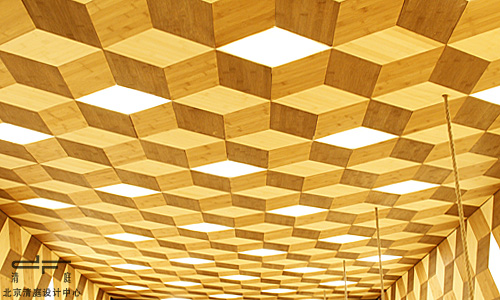
Bamboo flooring and LED lamps, which, when combined,
become a totally new type of construction material.
The combination of the bamboo flooring and LED industries has long existed. Now the designer, out of energy saving and environmental concerns, actively united the two into a new possibility. In the house, when the lamp is turned off, we see mosaic bamboo flooring made up of three different levels of colors; science and technology is introduced only when the lamp is on: in designated areas, the gentle light of LED lamps would pass through the bamboo skin.
There are a host of combinations of bamboo flooring and LED lamps. In an extremely simple space, energy is saved, for unnecessary lighting decorations are removed here, without impairing the lighting effects. The living space has also been enlarged. The design displayed in the exhibition is only a small but complete representation of such combinations. It may also be used in larger spaces, such as siheyuan (四合院, traditional four-sided enclosed courtyards) or modern buildings.
I adopted the bamboo design to echo modern environmental issues. This brand new solution was developed on the basis of traditional Chinese design philosophy.
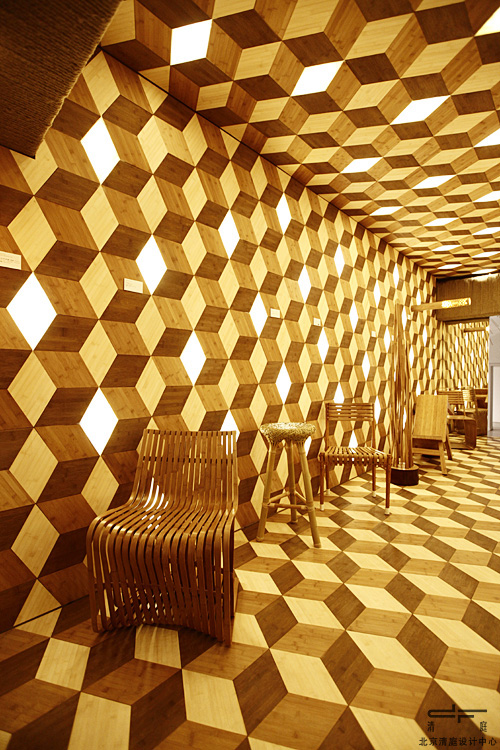
The bamboo designs displayed in the bamboo house
The bamboo designs displayed in the bamboo house includes: the bamboo electric fan from “Breeze” by Yu-Jui Chou; the vase from “Blossom scene” combining ceramics and bamboo weaving by Po-Ching Liao; the bamboo-weaved handbag from “Lightness” by Chun-Hao Chen; the butterfly wing shaped bamboo fan by Shih-Wen Chang; the bamboo chair which can serve both as a bench and a sling chair from “Dong Dong Qiang” by Chih Kang Chu; the cantilever bamboo chair “43” from the joint effort by Konstantin Grcic, an internationally renowned designer and Gao-Min Chen, a bamboo craft master from Taiwan; the bamboo chairs from “Chair Jun Zi” and “Chair Qin Jian” designed by myself, both winners of Red Dot Design Award with the former shaped as the Chinese character “Jun”, bringing the toughness and flexibility of bamboo into full play, and the latter inspired by the bamboo sword industry once flourished in Taiwan.
There is a variety of bamboo designs in the bamboo house, through which, valuable traditional arts and crafts are combined with modern designs. Environmental technologies that correspond to nature have also been adopted. A new life is given to old-fashioned traditions, which now may be employed practically in modern life. The exhibition is the best proof of the values of tradition.
The bamboo house, in addition to the designs inside, is able to correspond to current cultural heritage and cultural development. Hence it is capable of a spiritual conversation with the modern era. It embodies the creativity of design in various aspects, including product, space, architecture, art, and graphic design, etc. Design, in my eyes, involves mobilizing one’s desires, goodwill, wisdom, experience, common sense and curiosity to communicate with nature, probe into the present and the future, and cope with the various issues of human existence. I sincerely expect that “Bamboo Design”, under the theme of “altruism, Zeitgeist and social responsibility”, will add to the quality of the natural environment and human civilization.
back to top
Contact : Win 010-8440-7909 1510-1581-037
info@dragonfly-china.com
Text and photo credit: Dragonfly Design Center